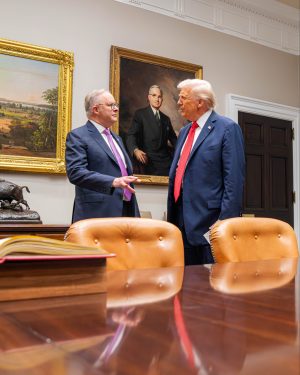This week Australian Prime Minister Anthony Albanese had his first meeting with U.S. President Donald Trump at the White House. As other world leaders have discovered, a trip to the White House comes with significant risks. It is impossible to know how Trump may react to any given situation; the normally tightly scripted bilateral meetings between leaders can veer off course very quickly. Often the risk of meeting with him outweighs any potential advantages.
However, aside from one Australian reporter with a petty vendetta goading the president into attacking Australia’s ambassador to Washington, former Prime Minister Kevin Rudd, the meeting went spectacularly well for Albanese.
Key to the success of the meeting was that Albanese came bearing gifts. It wasn’t a new 747 for Trump’s use, but a new deal on rare earths and critical minerals that would significantly enhance the United States’ hand in its strategic competition with China over current and emerging technologies. The technologies that rely on critical minerals include everything from military and medical equipment to green energy hardware to entertainment devices.
Currently China has a massive advantage in rare earths and critical minerals. It has around half of the world’s known deposits of these resources, while also dominating their processing – accounting for around three quarters of all production. And amid the Trump-launched trade war, Beijing has rolled out a series of export control measures to demonstrate its ability to snarl global supply chains. Given the importance of these minerals to emerging technologies, Washington rightly sees China’s control of the industry as a considerable strategic disadvantage that it needs to rectify.
While lacking the volume of known deposits of China, Australia still has a considerable amount – currently estimated at around 13 percent of the global total. Australia’s Critical Minerals Strategy 2023-2030, and its Future Made in Australia initiative are both designed to transform Australia from just being a quarry into a major processor of these minerals as well. Canberra is investing in this transformation, but encouraging U.S. investment will clearly accelerate this trajectory.
During the Albanese-Trump meeting a new U.S.-Australia Critical Minerals Framework was announced. This framework includes an initial $1 billion investment from both countries over the next six months designed to unlock an on-going $8.5 billion pipeline of rare earths and critical minerals projects.
Two projects will be prioritized. In Western Australia, the Alcoa-Sojitz Gallium Recovery Project will seek to deliver around 10 percent of the world’s gallium supply – about 100 tonnes a year. Gallium is essential for advanced electronic warfare systems such as missile guidance technology and radar systems and also the LEDs and transistors found in smartphones.
The second project will be in the Northern Territory. The Arafura’s Nolans Project has the ability to produce about 5 percent of the world’s neodymium and praseodymium. These rare earth elements are essential for the production of high-powered magnets used in robotics, electric vehicles and wind turbines.
Under the framework other mining companies would be able to apply for financing for projects that are deemed to be of strategic importance to the U.S. and Australia.
For Australia, the deal places it at the center of competition over emerging technologies, which are both highly profitable and of critical strategic advantage. The objective is to create new, trusted supply chains for these minerals to lessen the current reliance on China. Australia has sensed an opportunity in the ongoing trade war between the U.S. and China to be the solution to Washington’s desire to decouple strategic industries from any dependency on Beijing.
The deal also highlights how Australia wants to be a major player in the world of innovation. With this, the new critical minerals framework can be seen as working in tandem with Pillar II of the AUKUS initiative – the trilateral partnership that includes the U.K. to develop advanced capabilities in emerging technologies. For too long Australia has been content to just dig stuff up and ship it overseas. There is now a push to be part of multiple stages of product development, with the hope of eventually creating a domestic advanced manufacturing capability.
The new framework also displayed a skillful piece of diplomacy by Albanese. Trump likes big things to announce, and likes to place himself at the center of the grand forces of global competition. The framework gives Australia greater investment in its domestic critical minerals capabilities, it gives the U.S. a reliable pipeline of these minerals for its technological development and competition with China, and it gave Trump a big win to keep him from using Albanese’s visit to create disruption.





























